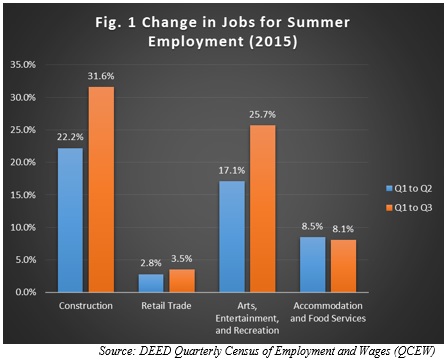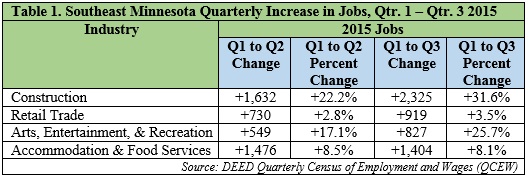 Southeast Minnesota is a health care and agricultural powerhouse. The region is home to the renowned Mayo Clinic and some of the world's most recognized food companies and brands.
Southeast Minnesota is a health care and agricultural powerhouse. The region is home to the renowned Mayo Clinic and some of the world's most recognized food companies and brands.
Advanced manufacturing is especially strong here, with machinery, chemicals, and electronics among the top products.
Want the freshest data delivered by email? Subscribe to our regional newsletters.
5/18/2016 2:23:55 PM
During the spring and summer months, nicer weather results in more jobs in certain industries in Southeast; specifically, construction, retail trade, accommodation and food services, and arts, entertainment and recreation. For evidence, we see a bevy of orange cones and detour signs, people shopping, residents enjoying music festivals and theater in the park, and diners lounging on the outdoor patio of the local eatery.
With so much extra activity in these four industries, it’s not surprising to see a jump in the number of jobs from quarter one to quarters two and three. This has been the trend in these four industries over several years, continuing in 2015. All four industries saw a jump in the number of jobs from quarter one to quarter two, and three of the four (except accommodation and food service) saw an additional jump from quarter two to quarter three in Southeast Minnesota (Figure 1).

As shown in Table 1, construction saw the largest increase with 2,325 additional jobs reported from quarter one to quarter three, an increase of 31.6 percent. Accommodation and food services and arts, entertainment, and recreation combined to add another 2,231 jobs in the region, while retail trade gained 919 net new jobs so far this year.

While it’s always nice to see an increase in jobs, there are issues. First, with the current and future labor force shortage in the Southeast region, some of these new jobs may be hard to fill, if they can be filled at all. According to Steve Hine, DEED’s Labor Market Information director, the region has seen a great decrease in annual labor force growth – the average annual growth from 1991 to 2002 was 3,308 new participants per year (1.4 percent), while the 12-year average from 2003 to 2014 dropped substantially to just 835 new workers per year (0.3 percent). And while the population continues to expand, much of the labor force growth over the next 15 years is projected to be workers aged 65 years and over staying in the workforce longer. Growth in these industries this summer may raise questions about where we are going to find workers to fill these new openings.
Second, many jobs in three of the four industries that show growth during the spring and summer are characterized by low pay – the exception being construction, traditionally a higher paying industry. The median wage offer for vacancies in these industries ranged from $9.57 to $14.56 last summer (Table 2). Though wage offers jumped for construction workers in the 4th quarter survey, they stayed relatively low in the other three industries.

Finally, construction aside, many of these were part-time jobs, so meeting cost-of-living needs may prove difficult if it is your only job. A full three-quarters of the vacancies in retail trade were part-time, while almost half of accommodation and food services jobs were offering part-time hours. On a related note, 80 percent of the vacancies in construction were temporary or seasonal, which means they may only be available during the summertime.
Though these characteristics may not make for a full-time, year-round career or meet cost of living needs, these industries do offer plenty of opportunities for a second job to provide extra income. Combined, the four industries offered nearly 3,500 vacancies last summer, and will likely do the same again this year. An individual may be able to work weekends and evenings in many positions to help pay for needs or to simply save in a rainy day fund.
Contact Mark Schultz.